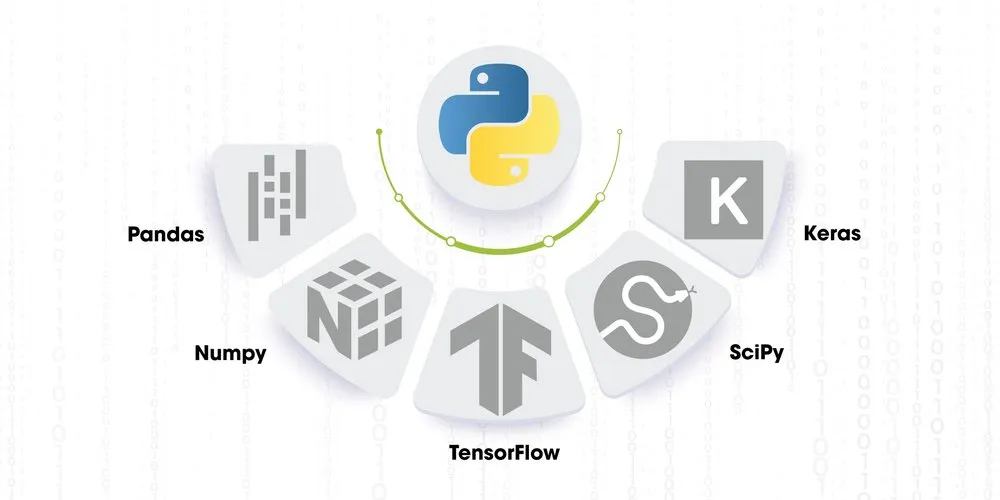Python is a computer programming language that is quite popular among everyone. It does not matter if you work in the development field, you must have heard of the Python language once in your life! Python is popular among developers for a variety of reasons, one of which is that it offers an incredibly huge library of libraries with which users may work. With its comfort and efficiency of use, it is a fairly basic computer program. Python wants its employees to be more prolific in all aspects of development, deployment, and maintenance. One other factor for Python's immense popularity is its adaptability. When compared to C, Java, and C++, Python's programming syntax is straightforward to learn and has a high level of abstraction.
What are Python libraries?
A Python library is a reusable code snippet that you can use in your programs and projects. The term 'library' refers to a collection of modules. This language includes a huge standard library and allows effective memory allocation. A Python library is a collection of programming languages that can be used in other Python projects. It is essentially a set of modules. Their value stems from the fact that they do not necessitate the creation of new codes every time the same procedure is required to run. Python libraries are useful for data science, machine learning, and data manipulation applications, among other things.
While referring to the Standard Library in Python, the term "library" is most usually used. The existence of a huge number of standard libraries in Python simplifies the life of a coder. The Standard Library is bundled with Python and installed alongside it, ensuring that its modules are always available to Python code. Python's Standard Library is a collection of the language's precise syntax, tokens, and interpretations. It's included in the standard Python installation. This is written primarily and takes care of things like I/O and other essential functions.
What are the common libraries in Python?
Here is a list of some common libraries in Python:?
1. Pandas:
Is Python suitable for data science? Yes, it's possible! Pandas is an example of a library that can assist you in achieving this goal. It offers fast, concise, and versatile data structures for working with organized (table form, multivariate, potentially diverse) and time-series information faster. It is a Python machine learning toolkit that includes high bandwidth structures as well as several analytical techniques. It ensures that the entire data manipulation procedure is simplified. Pandas include support for re-indexing, repetition, filtering, data analytics, sequences, and representations, among other activities.
2. NumPy:
NumPy is a popular and efficient Python library with advanced math capabilities and a fundamental compute-intensive suite. NumPy is a simple and exciting tool. It simplifies the execution of difficult mathematical equations. Coding becomes a lot easier, and understanding the ideas appears to be a lot easier. The language can be used to represent images, sound waves, and other binary raw streams as an N-dimensional array of real values.
3. TensorFlow:
TensorFlow is used in practically every Google machine learning model. It is designed to be fast, and it employs techniques such as XLA to do speedy basic mathematical computations. It functions as a cognitive library for building novel algorithms involving a huge number of tensor actions. Because neural pathways are easily defined as functional networks, TensorFlow can be used to implement them as a sequence of tensor operations. TensorFlow's libraries are developed entirely in C and C++. It is popular due to its useful properties, which include flexibility, a huge community, a dynamic structure, and the ability to be readily trained.
4. SciPy:
SciPy presents a multitude of numerical algorithms that are both user-friendly and effective. SciPy is a Python-based machine learning framework for programmers and researchers. Components for planning, linear programming, integration, and stats are included in this library. SciPy's key characteristic is that it was written in NumPy, and its collection makes extensive use of NumPy. Furthermore, SciPy uses its particular components to provide all of the effective computational algorithms such as optimization, numerical methods, and many others. The functions in SciPy's components are extensively documented.
5. Keras:
Keras is regarded as one of Python's most interesting deep learning packages. It's a Python-based framework, which makes it simple to debug and investigate. It also comes with several useful tools for constructing models, manipulating sets of data, graph visualization, and much more. It runs without a hitch on both the CPU and GPU. It supports nearly all neural network models, including fully connected, multilayer, filtering, repeating, integrating, etc. Such models can also be merged to create more sophisticated models. Its modular design makes it very expressive, adaptable, and well-suited to cutting-edge research. It allows neural networks to be expressed more easily.
Conclusion:
Python is a programming language with abundant libraries that help develop a wide range of applications in the real world. All you need now are some skilled python developers to accomplish your goals. We hope that this blog helped you understand the importance and efficiency of this high-level, dynamically typed, and interpreted language.










